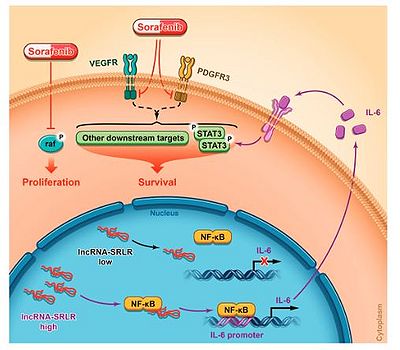Difference between revisions of "LNCSRLR"
Guangyu Wang (talk | contribs) (Created page with "==Annotated Information== ===Approved Symbol=== LNCSRLR ===Approved Name=== lncRNA sorafenib resistance in renal cell carcinoma associated ===Previous Symbols=== _ ===Synonyms...") |
Jiabao Cao (talk | contribs) (→Function) |
||
| (3 intermediate revisions by the same user not shown) | |||
| Line 1: | Line 1: | ||
==Annotated Information== | ==Annotated Information== | ||
| − | === | + | ===Name=== |
| − | LNCSRLR | + | LNCSRLR:lncRNA sorafenib resistance in renal cell carcinoma associated |
| − | + | ||
| − | lncRNA sorafenib resistance in renal cell carcinoma associated | + | lncRNA-SRLR<ref name="ref1" /> |
| − | === | + | ===Characteristics=== |
| − | + | LncRNA-SRLR is located on chromosome 3 in humans and is composed of 2 exons with a poly (A) tail and has a full length of 663 nt, as determined via a rapid amplification of cDNA ends assay.<ref name="ref1" /> | |
| − | === | + | |
| − | lncRNA-SRLR | + | ===Cellular Localization=== |
| − | === | + | The subcellular distribution assay reveals that lncRNA-SRLR is predominately located in the nucleus.<ref name="ref1" /> |
| − | + | ||
| − | === | + | ===Function=== |
| − | + | [[File:LncRNA-SRLR-fun.JPG|right|thumb|400px|'''Schematic diagram of lncRNA-SRLR-based regulatory mechanism in RCC cells'''<ref name="ref1" />.]] | |
| − | === | + | LncRNA-SRLR knockdown sensitizes nonresponsive RCC cells to sorafenib treatment, whereas the overexpression of lncRNA-SRLR confers sorafenib resistance to responsive RCC cells. Mechanistically, lncRNA-SRLR directly binds to NF-κB and promotes IL-6 transcription, leading to the activation of STAT3 and the development of sorafenib tolerance. A STAT3 inhibitor and IL-6-receptor antagonist both restore the response to sorafenib treatment. Moreover, a clinical investigation demonstrates that high levels of lncRNA-SRLR correlates with poor responses to sorafenib therapy in RCC patients.<ref name="ref1" /> |
| − | + | ||
| − | == | + | ===Expression=== |
| − | + | [[File:LncRNA-SRLR exp.JPG||right|thumb|400px|'''expression of ''LNCSRLR'''''<ref name="ref1" />.]] | |
| − | == | + | LncRNA-SRLR is preferentially upregulated in RCCs(Renal cell carcinoma) with inherent sorafenib resistance.<ref name="ref1" /> |
| − | + | ||
| + | ===Diseases=== | ||
| + | Renal cell carcinoma<ref name="ref1" /> | ||
| + | ==Labs working on this lncRNA== | ||
| + | *Department of Urology, Changzheng Hospital, Second Military Medical University, Shanghai, China. | ||
| + | ==References== | ||
| + | <references> | ||
| + | <ref name="ref1"> | ||
| + | Xu Z, Yang F, Wei D, Liu B, Chen C, Bao Y, Wu Z, Wu D, Tan H, Li J, Wang J, | ||
| + | Liu J, Sun S, Qu L, Wang L. Long noncoding RNA-SRLR elicits intrinsic sorafenib | ||
| + | resistance via evoking IL-6/STAT3 axis in renal cell carcinoma. Oncogene. 2017 | ||
| + | Apr 6;36(14):1965-1977. | ||
| + | </ref> | ||
| + | </references> | ||
Latest revision as of 07:01, 7 November 2017
Contents
Annotated Information
Name
LNCSRLR:lncRNA sorafenib resistance in renal cell carcinoma associated
lncRNA-SRLR[1]
Characteristics
LncRNA-SRLR is located on chromosome 3 in humans and is composed of 2 exons with a poly (A) tail and has a full length of 663 nt, as determined via a rapid amplification of cDNA ends assay.[1]
Cellular Localization
The subcellular distribution assay reveals that lncRNA-SRLR is predominately located in the nucleus.[1]
Function

LncRNA-SRLR knockdown sensitizes nonresponsive RCC cells to sorafenib treatment, whereas the overexpression of lncRNA-SRLR confers sorafenib resistance to responsive RCC cells. Mechanistically, lncRNA-SRLR directly binds to NF-κB and promotes IL-6 transcription, leading to the activation of STAT3 and the development of sorafenib tolerance. A STAT3 inhibitor and IL-6-receptor antagonist both restore the response to sorafenib treatment. Moreover, a clinical investigation demonstrates that high levels of lncRNA-SRLR correlates with poor responses to sorafenib therapy in RCC patients.[1]
Expression

LncRNA-SRLR is preferentially upregulated in RCCs(Renal cell carcinoma) with inherent sorafenib resistance.[1]
Diseases
Renal cell carcinoma[1]
Labs working on this lncRNA
- Department of Urology, Changzheng Hospital, Second Military Medical University, Shanghai, China.